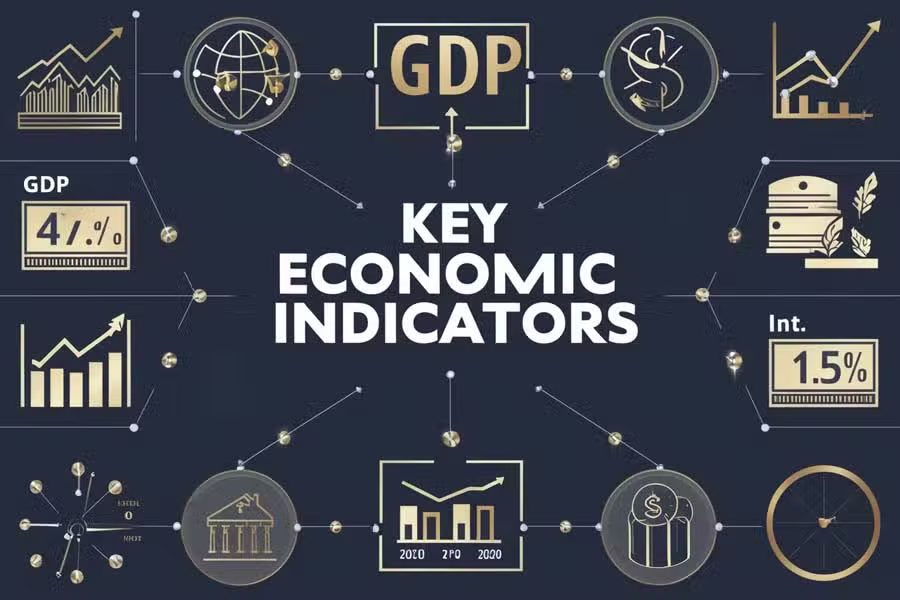
With over $2.4 quadrillion in total value and $7.5 trillion in daily trading volume, the forex market is the most lucrative and volatile market in the world. There are fortunes made and lost in the blink of an eye. In this high-stakes environment, understanding the underlying economic indicators is paramount to your trading success. These indicators act as signposts, guiding you through the tumultuous world of currency fluctuations. By mastering the top three economic indicators, you can make more informed decisions and anticipate market movements with greater accuracy.
1. Gross Domestic Product (GDP)
Understanding GDP
Gross Domestic Product (GDP) is the broadest measure of a country’s economic health and is often considered the most significant indicator. It represents the total monetary value of all goods and services produced over a specific time period. A growing GDP typically indicates a healthy economy, while a declining GDP may signal economic trouble.
Historical Example
In the aftermath of the 2008 financial crisis, the GDP of many developed nations plummeted, reflecting the widespread economic downturn. For instance, the United States saw a GDP contraction of about 2.5% in 2009. This decline correlated with a significant depreciation of the USD against other major currencies, illustrating the critical connection between GDP and forex market movements.
Why It Matters
By keeping a keen eye on GDP reports, you can gauge economic strength and predict central bank actions. For example, a robust GDP growth rate may lead to interest rate hikes by the central bank, boosting the national currency. Conversely, a weak GDP may prompt monetary easing, leading to currency depreciation.
2. Inflation Rates
Understanding Inflation
Inflation measures the rate at which the general price level of goods and services rises, eroding purchasing power. Central banks closely monitor inflation to maintain economic stability. Commonly tracked through the Consumer Price Index (CPI) and Producer Price Index (PPI), inflation provides insights into potential changes in monetary policy.
Historical Example
In the late 1970s and early 1980s, the United States experienced a period of high inflation, reaching nearly 15% in 1980. The Federal Reserve responded with aggressive interest rate hikes, which in turn led to a substantial appreciation of the USD. This historical example underscores the influence of inflation and central bank responses on forex markets.
Why It Matters
By monitoring inflation trends and central bank responses, you can better predict currency movements. High inflation often prompts central banks to raise interest rates to curb excess spending, leading to a stronger currency. Conversely, low inflation or deflation may result in lower interest rates to stimulate spending, weakening the currency.
3. Employment Data
Understanding Employment Data
Employment data, including non-farm payrolls (NFP), unemployment rates, and jobless claims, are crucial indicators of economic health. High employment rates signify economic strength, while rising unemployment can indicate economic distress.
Historical Example
During the COVID-19 pandemic, global economies faced unprecedented employment challenges. In April 2020, the US unemployment rate soared to 14.8%, the highest since the Great Depression. This spike in unemployment led to significant volatility in the forex market, with the USD experiencing substantial fluctuations as traders reacted to economic uncertainty.
Why It Matters
Employment data directly influence consumer spending and economic activity. Positive employment trends can boost economic confidence and currency strength, while negative trends can have the opposite effect. Central banks also consider employment data when making monetary policy decisions, making it a vital indicator for you to monitor.
Trade the Forex Market with GVD Markets
Forex trading offers numerous opportunities for beginners to grow their investments, but it requires a solid understanding of effective strategies. The trend following, breakout, and news trading strategies provide a strong foundation for novice traders. By leveraging historical examples and expert insights, beginners can navigate the forex market with greater confidence and increase their chances of success.
Remember, successful trading involves continuous learning, disciplined risk management, and staying updated with market developments. As you embark on your forex trading journey, these strategies will serve as valuable tools to help you achieve your financial goals.
At GVD Markets, we are committed to supporting our traders with cutting-edge tools, educational resources, and expert guidance. Our world-leading MetaTrader platforms offers a user-friendly interface, real-time market data, and advanced charting tools to help you make informed trading decisions. Whether you are a beginner or an experienced trader, GVD Markets provides the resources you need to succeed in the dynamic world of forex trading.
Join GVD Markets today and take the first step towards mastering the forex market. With our comprehensive support and innovative trading solutions, you can confidently pursue your trading ambitions and work towards achieving financial independence. Start trading with GVD Markets and unlock the potential of the forex market.
Start Trading with GVD Markets
